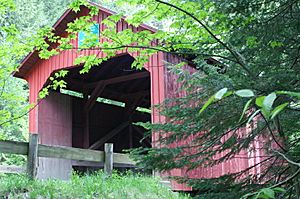Stony Brook Covered Bridge facts for kids
Quick facts for kids Stony Brook Covered Bridge |
|
|---|---|

Bridge in U.S. state of Vermont
|
|
| Carries | Automobile |
| Crosses | Stony Brook |
| Locale | Northfield, Vermont |
| Maintained by | Town of Northfield |
| ID number | VT-12-07 |
| Characteristics | |
| Design | Covered, King post |
| Material | Wood |
| Total length | 36.75 ft (11.20 m) |
| Width | 15.8 ft (4.82 m) |
| Number of spans | 1 |
| History | |
| Constructed by | John Moseley |
| Construction end | 1899 |
| Area | 1 acre (0.4 ha) |
| NRHP reference No. | 74000266 |
| Added to NRHP | November 20, 1974 |
The Stony Brook Covered Bridge, also known as the Moseley Covered Bridge, is a cool wooden bridge in Northfield, Vermont. It crosses a stream called Stony Brook. This bridge was built way back in 1899. It's special because it's one of only two bridges in Vermont from the 1800s that uses a design called a King post truss. The bridge is so important that it was added to the National Register of Historic Places in 1974.
What is the Stony Brook Bridge Like?
The Stony Brook Covered Bridge is in a quiet, countryside part of Northfield. It carries Stony Brook Road over the Stony Brook stream. This bridge is a single-span structure. It means it crosses the water with just one main section.
The bridge is about 36.5 feet (11.1 m) long. It is 19 feet (5.8 m) wide in total. The part where cars drive is about 16 feet (4.9 m) wide, which is enough for one lane of traffic.
How Was the Bridge Built?
The bridge has a gabled roof, which looks like a house roof. Its outside walls are made of vertical wooden boards. These boards go a little way inside the bridge's openings. The siding does not go all the way to the roof. This leaves an open space along the top.
The bridge sits on stone supports called abutments. These supports have been covered with concrete. The road surface of the bridge is made of wooden planks.
History of the Stony Brook Bridge
The Stony Brook Covered Bridge was built in 1899. Many people believe it was the last King post truss bridge built in Vermont during the time when covered bridges were very common. It is one of only two historic bridges of this design still standing in Vermont today. The other one is the Pine Brook Covered Bridge.
Northfield is a special place for covered bridges. The Stony Brook Bridge is one of five covered bridges in the town. This makes Northfield one of the places with the most covered bridges in Vermont!
Over the years, the bridge has had some updates. In 1971, five steel beams were added underneath to make the bridge deck stronger. In 1990, the original stone supports were covered with concrete to protect them.



